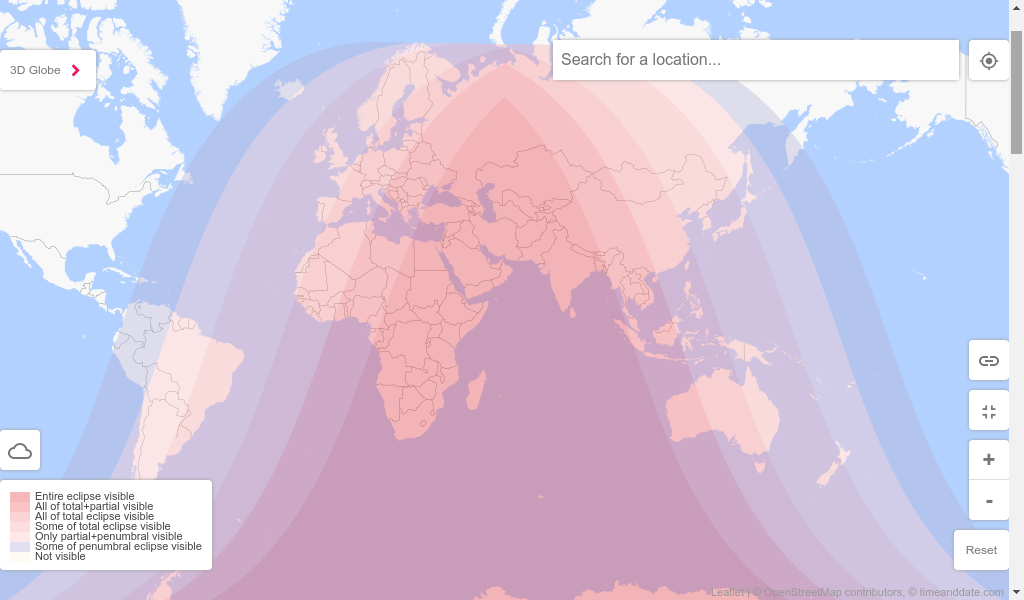Lunar Eclipse July 2018: Time to Pray


Map showing the regions where the "Total Lunar Eclipse" of 27-28 July 2018 will be visible. (Timeanddate.com)
On the last weekend of this month, July 2018, there will be a total lunar eclipse. The eclipse will be on the Friday/Saturday night, 27-28 July 2018. The total lunar eclipse will last about 103 minutes and is calculated to be the longest total lunar eclipse of this century (2001-2100). The eclipse will be visible in: much of Europe, much of Asia, Australia, Africa, South in North America, South America, Pacific, Atlantic, Indian Ocean, Antarctica.
Map showing the regions where the “Total Lunar Eclipse” of 27-28 July 2018 will be visible. (Timeanddate.com)
The lunar eclipse on 27 July 2018 is also called micro blood moon, because the moon is farthest from the earth and the appearance of the moon during the totality would be reddish in color.
More information about the eclipse and the local times when this event occur can be found here.
Eclipse Prayer for Muslim
Simulation of the total lunar eclipse, showing the reddish color of the “Blood Moon” that occurs during totality.
For muslims, the events of both lunar and solar eclipse are regarded as special times to show our humbleness and gratitude to Allah, the One who created both the sun and the moon. The times of eclipse are times for special sunnah (non-obligatory) prayer.
The Prophet Muhammad pbuh., said, ‘When you see that (an eclipse), supplicate Allaah, make Takbeer, pray, and offer charity.’ [Related by Al-Bukhari and Muslim]
“Verily, the sun and the moon are two of the signs of Allah and they do not eclipse on account of the death or birth of anybody. So whenever you see this, pray and invoke (Allah) until it is over.
[Related by Muslim]
When an eclipse occurs, it is an act of the Sunnah to remember Allaah, supplicate Him, seek His forgiveness, recite Takbeer, offer charity, free slaves, and draw closer to Allaah Almighty with whatever one is able to do of good deeds. It is an act of the Sunnah to perform the Eclipse Prayer in congregation, and it is also allowable to perform it individually at home or elsewhere. The Shaafi‘is and Hanbalis held that performing the Eclipse Prayer in congregation is an act of the Sunnah for both the solar and lunar eclipses. The Hanafi view and the famous view of the Maalikis is that the Eclipse Prayer should not be performed in congregation in case of the lunar eclipse.
How To Perform Eclipse Prayer
“Scholars held different views regarding the perfect manner of performing the Eclipse Prayer and not the sufficient manner. It is sufficient to perform the Eclipse Prayer as two Rak‘ahs like other voluntary prayers according to all scholars. The least perfect manner of performing the Eclipse Prayer according to the three scholars (Ash-Shaafi‘i, Maalik, and Ahmad ibn Hanbal) is as follows: The praying person should recite Takbeerat Al-Ihraam (opening Takbeer [saying: Allaahu Akbar]) with the intention of performing Salat Al-Kusoof (Eclipse Prayer), recite the Faatihah, bow, rise from the bowing and stand upright in tranquility, bow a second time, rise and stand upright observing tranquility, perform two prostrations, and then do the same in the second Rak‘ah. Thus, the Eclipse Prayer is a two-Rak‘ah prayer each consists of two standing positions, two bowing positions, and two prostrations. The rest of the prayer is normal; reciting Soorahs from the Quran, Tashahhud, and tranquility. The Hanafis, on the other hand, held that it is two Rak’ahs, each with one standing position, one bowing position, and two prostrations, like all other voluntary prayers.”
[IslamWeb]
Eclipse Prayer Acoording to Maliki, Shafi’i and Hanbali School
It is a sunnah to perform Salatul Kusuf whenever there is a solar eclipse. According to the Hanafis and Hanbalis, it is nafl. The imam goes to the mosque and begins to lead the people in prayer without either an adhan or an iqama. It is recommended that it be performed in congregation, but it can also be performed at home, by oneself. The complete method to pray the solar eclipse prayer is as follows:
- Make an intention to pray this sunnah prayer and make the opening takbir.
- Recite (inaudibly) the Fatihah and a long surah of the Quran i.e. Surah al-Baqarah or its like.
- Say ‘Allahu Akbar’ and go into ruku. Stay in ruku for a considerable period of time.
- Say ‘Sami’ Allahu li-man Hamida’ and stand back up.
Recite the Fatiha, again, followed by another long surah of the Quran that is not as long as the previous one i.e. Surah Aali ‘Imran or its like. - Say ‘Allah Akbar’ and go into ruku, less prolonged than the first.
- Say ‘Sami’ Allahu li-man Hamida’, followed by‘Rabbana wa laka l-Hamd’.
- Then make two prolonged prostrations (Sajdatain).
- Say ‘Allahu Akbar’ and stand back up.
- Repeat steps (2) through (8), however, not as prolonged as the first; reciting Surah an-Nisa (or its like) in the third standing and Surah al-Ma’idah(or its like) in the fourth.
- Say ‘Allahu Akbar’ and sit back up.
- Finally, say the tashahhud and then the salam
According to the Shafi’is and some Hanbalis, the imam then gives a sermon (Khutbah). However, according to the Malikis, there is no khutbah, but there is no harm in the imam taking the opportunity to admonish and remind the people.
Recent Posts
Crescent Moon (Hilal) Photos of Shawal 1446 AH (2025 CE)
In this post, we will update crescent moon photos for the month of Shawal 1446…
Crescent Moon Photos of 1 Ramadan 1446 AH (2025) From Around the World
Welcome Ramadan! Ahlan wa sahlan the month of blessings and rewards! In this post, we…
When is 1 Ramadan 1446 AH (2025 CE)?
It is Ramadan time, again! Alhamdulillah, praise be to Allah that brings us closer to…
Crescent Moon Photos of 1 Sha’ban 1446 AH
As previously posted, the crescent moon of Sha'ban 1446 AH will be easily visible for…
When is 1 Sha’ban 1446 AH?
The eighth month of the hijri calendar this year, Sha'ban 1446 AH, is around the…
Exploring the Names and Origins of Jumadal Akhirah Across the Muslim World
In our previous post, we introduced the arrival of Jumadal Akhirah 1446 AH. This month,…


